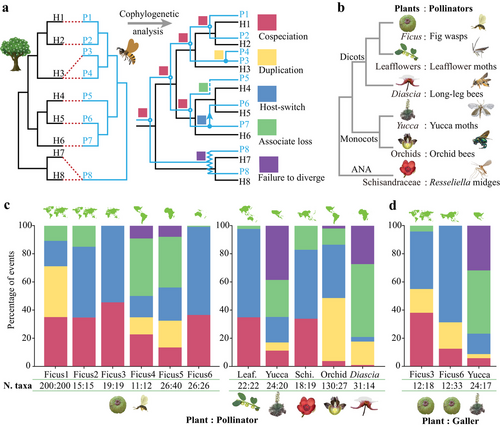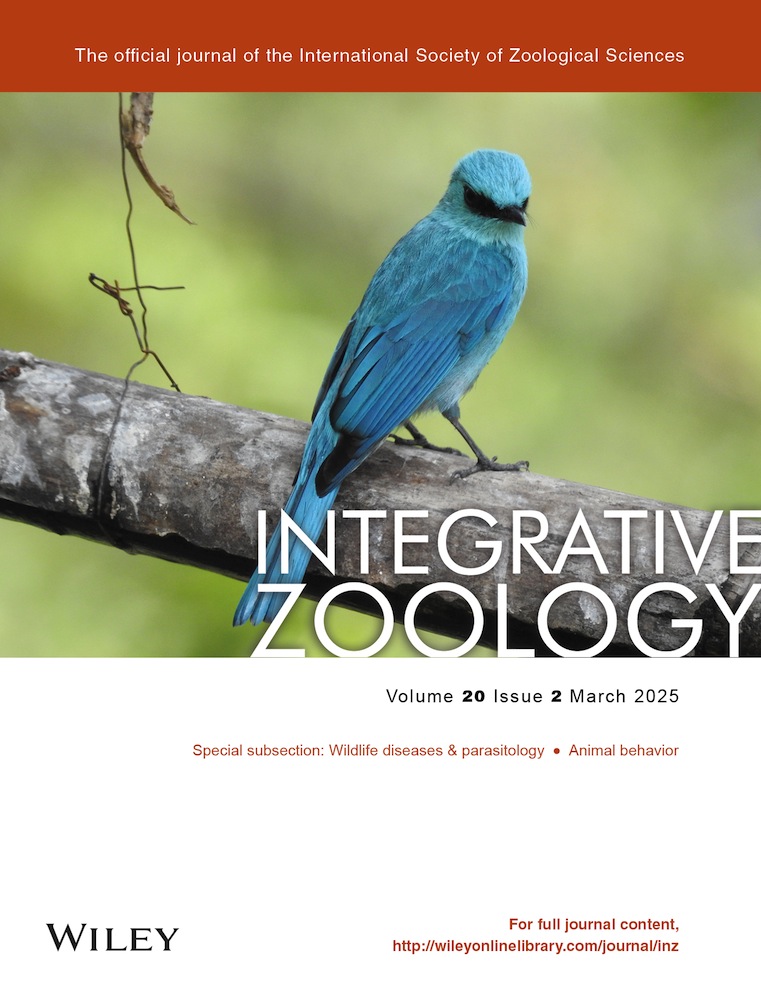Cospeciation is not the dominant driver of plant–pollinator codiversification in specialized pollination systems
Abstract
This study systematically rejects the long-standing notion of cospeciation as the dominant driver of codiversification between flowering plants and their specialist pollinators. Through cophylogenetic analysis of six classical specialized pollination systems, the research finds that cospeciation events are consistently outnumbered by non-cospeciation events, such as host-switch, duplication, and association losses. The findings support a more dynamic and diffuse codiversification paradigm, highlighting the importance of considering a broader range of evolutionary events in understanding plant–pollinator codiversification. This new understanding is robust across diverse pollination systems and has significant implications for conservation strategies in the face of environmental change.
Flowering plants and their insect pollinators, two of the most diverse and coevolved groups, play a crucial role in terrestrial ecosystems (Tong et al. 2023). The mechanism of plant–pollinator codiversification is a fundamental inquiry in evolutionary biology and conservation. A traditional notion of plant–pollinator codiversification through cospeciation has been widely spread (Friedman 2009; Schiestl & Schluter 2009; Cruaud et al. 2012), while the direct empirical evidence is limited and systematic testing is lacking.
Different coevolution concepts, strict-sense versus diffuse, influence our understanding of plant–pollinator codiversification. The popularity of the cospeciation-dominated codiversification paradigm matches well with the wild-spread of the strict-sense coevolution concept. It defines the coevolution process as the evolutionary change in traits of one species (population) in responding to changes in traits of another species (population) exactly, followed by inverse effects (Janzen 1980). So, plant–pollinator cospeciation is likely to be the ultimate outcome of trait evolution under continuous reciprocal selection between species pairs, thus dominating their codiversification. This paradigm is frequently used to understand the codiversification of highly specialized pollination systems. However, most plants and pollinators form generalized pollination interactions and diffuse interactions are reported even in the most extreme specialized pollination systems, such as the fig–fig wasp system (Cruaud et al. 2012; Wang et al. 2016). The above perspective is being questioned by the diffuse coevolution concept, which allows the fact that each plant or pollinator species could coevolve with multiple partners (Janzen 1980). This suggests that, in addition to cospeciation, other evolutionary events such as host-switch and association losses significantly contribute to the codiversification of these two groups (Ramirez et al. 2011; de Vienne et al. 2013; Kahnt et al. 2019; Satler et al. 2019; Wang et al. 2021).
Furthermore, conflict evidences coexist in empirical studyies. On one side, the cospeciation-dominated notion aligns with highly specialized relationships, trait matching, and high-scale phylogenetic congruence observed in many specialized pollination systems (Schiestl & Schluter 2009; Cruaud et al. 2012; Peña-Kairath et al. 2023). On the other side, pollinator host-switch and fine-scale phylogenetic incongruence are increasingly detected in independent studies focused on single system or local site with various methods, indicating a more dynamic diffuse coevolutionary process (Ayasse et al. 2010; Kawakita 2010; Kahnt et al. 2019; Satler et al. 2019; Wang et al. 2021). Therefore, a systematic evaluation of cospeciation and other non-cospeciation evolutionary events, like host-switch, on driving plant–pollinator codiversification with standardized methods is necessary. Here, for the first time, we conducted systematic cophylogenetic analyses on 11 datasets of six classical specialized pollination systems and evaluated the relative contribution of cospeciation and other evolutionary events responding to the plant–pollinator codiversification. We found that cospeciation events are always lower in frequency than those of non-cospeciation events in all detected systems.
The frequency of five evolutionary events responding to the plant–pollinator codiversification was inferred with cophylogenetic analysis based on the phylogenies of plants and their pollinator as well as their associative information (Conow et al. 2010). The five events include cospeciation and four independent non-cospeciation events, host-switch, duplication, association losses, and failure to diverge (Fig. 1a; see Supporting Information for details). The six plant–pollinator systems chosen here are all highly specialized pollination systems, well-known for their high species diversity and intricate morphological and behavioral adaptations. They include the fig–fig wasp (Cruaud et al. 2012), Yucca–yucca moth (Althoff et al. 2012), leafflower–leafflower moth (Kawakita 2010), Schisandraceae–midge (Luo et al. 2018), orchids–orchid bee (Ramirez et al. 2011), and Diascia–long-leg bee systems (Kahnt et al. 2019). These systems span across different geographical scales and major clades of angiosperms (Fig. 1b; Table S1, Supporting Information). Of them, the first four systems, related to the genera Ficus (figs, Moraceae) and Yucca (yuccas, Asparagaceae) and families Phyllanthaceae (leafflowers) and Schisandraceae plants, are also called the brood-pollination systems, in which the pollinator larvae develops and feeds inside the flower tissue, and both the plant and the pollinator have to depend on each other for reproduction successfully, so much higher pollination specificity and stable relationship are expected (Kato & Kawakita 2017). The last two systems, consisting of Neotropical orchids, African Diascia (Scrophulariaceae) plants, and their free-living oil-collecting bee pollinator (Ramirez et al. 2011; Kahnt et al. 2019), are more similar to the generalized pollination systems (see Supporting Information for details).

The fig–fig wasp system represents the most extreme example of specialized pollination systems, often described as a “one-to-one” relationship and a classical model system for studying plant–animal coevolution and cospeciation (Cruaud et al. 2012). Contrary to common belief, our findings reject the default model of codiversification through cospeciation in this extremely specialized pollination system, with datasets of six fig–wasp groups across all major tropical continents and different representative taxonomical groups and species numbers. We find the frequency of cospeciation event only reaches 44.44% to 14.64%, which is always lower than that of other evolutionary events, such as pollinator host-switch (62.80–15.03%), duplication (independent speciation of the pollinators, 36.11–13.64%), and association loss (39.88–0%) (Fig. 1c). Similar patterns are also observed in the other five specialized pollination systems (Fig. 1c). First, for other three brood-pollination systems, cospeciation takes only 34.96%, 33.88%, and 11.04% of all the evolutionary events in leafflower–leafflower moth, Schisandraceae–midge, and yucca–yucca moth systems respectively, while it is the pollinator host-switch as the dominant event in leafflower (62.61%) and Schisandraceae systems (49.02%), and three non-cospeciation events (83.16% in total) happen more frequency in the yucca system. When checking the rest two pollination systems with free-living pollinators, the cospeciation event contributes just marginally—2.81% in the Neotropical orchids–orchid bee system and 0.69% in the African Diascia–long-leg bee system. They are duplication event (46.45%) and host-switch event (37.82%) in the orchids–orchid bee system, the associate loss event (50.69%) and failure to diverge event (28.47%) in the Diascia-long-leg bee system, dominate the plant–pollinator codiversification history (Fig. 1c).
In addition, the prevalent pattern of non-cospeciation events along the plant–insect codiversification process is also detected in some antagonistic relationships, which adhere to the above specialized pollination systems. Similar cophylogenetic analyses were conducted between plants and their specialized gall insects in the fig–fig wasp and yucca–yucca moth systems and got similar patterns. The cospeciation event takes only 38.00% and 12.50% of all evolutionary events in two fig–galling wasp systems and 5.80% in one yucca–galling moth system. While there is the host-switch event (68.75%, 40.90%) in the two fig–galling wasp systems and the association loss event (44.93%) in the yucca–yucca moth system happen most frequently along plant–galler codiversification (Fig. 1d). The relatively higher non-cospeciation events, such as host-switch or association loss, along with plant–galler codiversification, suggest a strong arms race between the antagonistic partners (Wang et al. 2019). Considering that both pollinators and galling insects coexist in the same host plants but exert opposite pressure, the negative selection supplied by gall insects to their host plants or coexisting pollinator insects may be an important driver reshaping the plant–pollinator interactions and stimulating the plant–pollinator diversification through those non-cospeciation events.
In conclusion, even with the increasing reports on host-switch in specialized pollination systems, the traditional notion of plant–pollinator codiversification through cospeciation is still upheld, as most of the previous workings are case studies with a single system, or single site studies, and with different incomparable analysis methods. Based on a systematic survey and reanalysis of published plant–pollinator phylogenies and species association information crossing 11 datasets of the six most classical specialized pollination systems, which cross all major continents and major clades of angiosperms, for the first time, we rejected systematically the longstanding notion of plant–pollinator cospeciation event dominating their codiversification. Instead, our results support a more diffuse and dynamic codiversification paradigm, wherein the dynamic nature of pollination specificity is frequently disrupted by host-switch, pollination duplication, association losses, and failure to diverge events (Machado et al. 2005; Hembry & Althoff 2016; Wang et al. 2021). Meanwhile, this diffuse codiversification paradigm also applies to the antagonistic plant–insect systems as similar pattern revealed in two plant–galler systems adhere to the pollination systems. It should be noted that although all phylogenies used here have been formally published, some phylogenies are less robust than others (see Supporting Information for details), which may influence certain cophylogenetic results that largely depend on the phylogenetic topologies. However, considering that the same results are consistently supported by all our independent datasets from 11 plant–pollination cases and three plant–galler cases spanning six specialized pollination systems, which across all major continents and main clades of angiosperms, our conclusion on a diffuse codiversification paradigm should be very robust.
The diffuse codiversification paradigm also offers new insight into current conservation facing a rapidly changing environment. In the evolutionary view, the new paradigm suggests that the reshaping or breakdown of established specialized plant–insect interactions does not have to be a totally negative phenomenon for biodiversity conservation. The interaction–reshaping is very common along their diversification history and can lead to plant–insect diversification frequently via host-switch and other events (Wang et al. 2021; Su et al. 2022). In the face of the extensive reshaping of current ecological interactions amidst rapidly changing environments (Bascompte et al. 2019; Fricke & Svenning 2020), both extinction risks and diversification opportunities are possible. Exploring how we might modify these evolving ecological networks to facilitate current species adapting to the rapid changing environment and even stimulate their new diversification is an intriguing and meaningful topic. After all, without breakdowns, there can be no creation. Thus, it is crucial to seek hope and opportunities amidst the inherent risks.
ACKNOWLEDGMENTS
This work was supported by the Distinguished Youth Scholar of Yunnan Province, China (202201AV070007), the National Natural Science Foundation of China (32371701, 32250410312), the Yunnan Revitalization Talent Support Program, Young Talent Project, the Youth Innovation Promotion Association of CAS (2020392), the 14th Five-Year Plan of XTBG, CAS (E3ZKFF3B), and the CAS Key Laboratory of Tropical Forest Ecology (O9KF001B04).
CONFLICT OF INTEREST STATEMENT
The authors declare no competing interests.
Open Research
DATA AVAILABILITY STATEMENT
Supplementary methods and raw results are available as supporting information for this paper.




